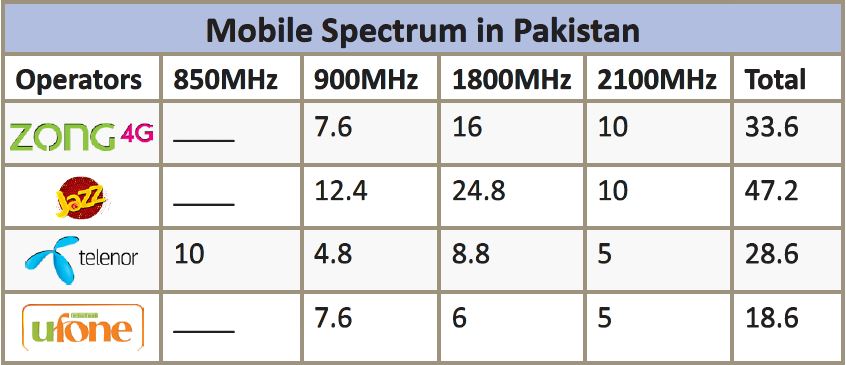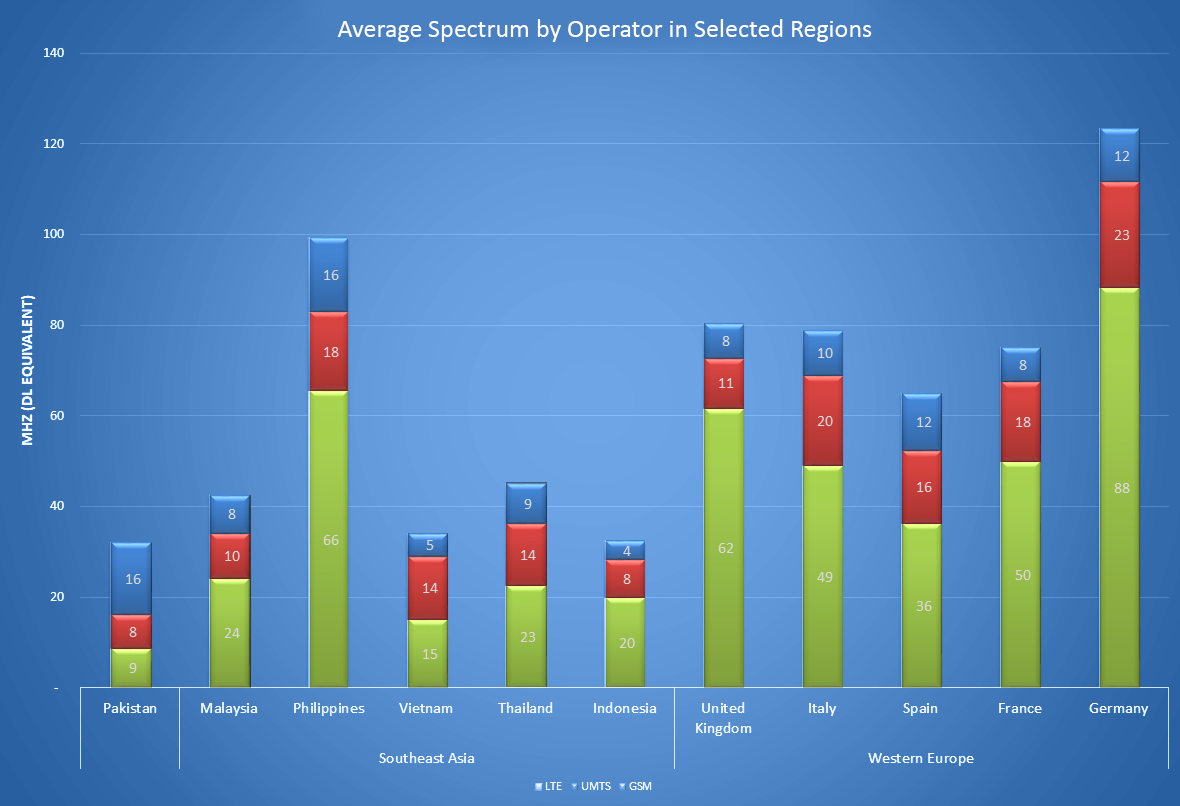Significance of Spectrum Management for Mobile Operators

After the industrial revolution of the 19th century, the technology revolution of the current era has perhaps made the biggest impact on the world so far. It has brought communications to hundreds of millions of people across the world within a limited period of time. After the advent of Next Generation Mobile Technology, mobile operators have become the biggest providers of internet services. This rapid and widespread success of mobile broadband is at the center of the technology revolution. It has also helped operators to achieve their key strategic goals by increasing their data revenues to balance out declining voice revenues.
Pakistan is no exception in digital mobile revolution except that it started off a little late but the developments that have taken place over the last decade are quite impressive
Pakistan is no exception in this digital mobile revolution except that it started off a little late but the developments taken place in the ICT sector over the last decade are quite impressive. In just four years, mobile broadband subscribers reached 40 million while cellular subscribers reached 144 million up from 114 million in 2014. Telecom imports rose to 333.701 million dollars in Q1 2017-18 whereas, more than 40% mobile phones imported in the country are smartphones.
Mobile operators are ramping up mobile broadband services but data traffic is growing much faster than data revenues
The imprint of mobile technology has gone beyond ICT industry and we can taste the bounties of mobile technology in commerce, agriculture, education and baking among other sectors as well.
Why Pakistan Needs More Spectrum?
Mobile operators are ramping up mobile broadband services but data traffic is growing much faster than data revenues. It is partly due to the launch of flat-rate tariffs for mobile broadband.
Even the biggest telecom operators of the world are facing the same dilemma, Vodafone, T-Mobile, AT&T Telecom Italia and many other operators have reported that mobile broadband subscribers and data uptake has increased many folds but the increase in data revenues is not at par with that.
Although the operators around the world are facing the same issue but as compared to Pakistan, they are in a far better position. They are not only technically more advanced with the efficient network but at the same time, they also have much larger spectrum at hand. Consequently, they incur much less cost to run their businesses. At the same time, Pakistan has relatively less mobile data consumption per month i.e. approx. 850Mbs as compared to other countries.
Spectrum is the most valuable asset for mobile operators due to its role in improving service coverage or capacity, or both as data speeds have become the key driver for operators’ network strategies. In Pakistan, mobile services are provided at a total of 128 MHz in 850 MHz, 900 MHz, 1800 MHz, and 2100 MHz spectrum whereas, for next-generation mobile service, the spectrum quota is much lesser. Below is the mobile spectrum map Pakistan.
Pakistan has assigned least spectrum for LTE as compared to other countries. Secondly, Pakistan still has the highest allocation of 2G Bands. Because of such unfavorable conditions, the average mobile data consumption per connection per month in Pakistan is way too low as compared to similar markets as well as western markets.
Mobile subscribers in Pakistan are increasing at a steady pace. With increased subscriber base, data usage is also growing and use of IoT services is progressing as well. In future, this growth will further fortify, setting the ground for need of additional spectrum and better spectrum management strategies.
Another crucial reason that is adding up to the need of more spectrum is the cost associated to LTE network expansion with limited spectrum at hand. To fulfill the needs of larger subscriber base operators have to install more base stations hence, resulting in increased OPEX and CAPEX. Through appropriate spectrum planning, operators can cut down this cost. Additionally, availability of low-cost LTE devices has given rise to increase in LTE subscriber base consequently resulting in need of more spectrum.
What Are the Options?
With the dramatic growth in telecom and IT industry, we can see a number of services and products going digital. The available spectrum might be sufficient today but in future, it won’t be able to satisfy the growing needs of the Pakistani consumers. Leaving operators with two possible options, either to acquire more spectrum through bidding in the auction or by refarming existing spectrum.
- Spectrum Acquisition through Auction
In a limited time span of five years, Pakistan government has organized three NGSM auctions that have enabled mobile operators to acquire large spectrum chunks for their 3G and 4G services.
The available spectrum might be sufficient today but in future, it won’t be able to satisfy the growing needs of the Pakistani consumers.
There is still 19.1 MHz block available in 1800 MHz while 30 MHz block is available in 2100 MHz frequency. But relying entirely on spectrum auction to fulfill the need of upgraded network is not a feasible deal for mobile operators. Firstly, it is a very costly affair and requires huge investment, not only for bidding but also for network upgrading. Secondly, it is up to the government to decide when to hold an auction.
- Refarming
Acquiring additional spectrum is a onetime investment and benefits can be reaped for many years to come. But since the release of additional spectrum is not in the hands of operators, the next best thing they can do is refarm their existing spectrum to fulfill their spectrum needs.Farming of spectrum is one of the methods to make some extra carriers available by shifting GSM bands to LTE.
With more spectrum at hand, mobile operators will require a lesser number of Base stations
In this way, operators can increase their LTE bandwidth by slowly and gradually migrating 2G subscriber to 4G. Farming is the most inexpensive method to increase LTE spectrum that can be achieved with careful RF planning. Let’s look at some of the benefits refarming can bring for the operators and the overall industry.
Economic Benefits:
No matter how socially responsible and active an organization is, at the end of the day, all commercial businesses have one basic motif i-e- revenues. Their main objective is always to cut the cost wherever possible while maintaining their quality of products and services. Mobile operators also try to strategize their plans on the same lines. The reason why mobile operators should and will move towards acquiring additional spectrum and refarming strategy in the future is cost efficiency.
Mobile operators incur huge cost annually in the shape of network maintenance. To keep one BTS up and running, an operator spends millions of rupees every month. Besides the Network equipment and maintenance cost, site rentals, petrol and other utility expense, security, human resources add up to the overall cost of network maintenance.
With more spectrum at hand, mobile operators will require a lesser number of Base stations. The more the spectrum is, the lesser the number of sites required, keeping the coverage area same. More Spectrum provides more carriers that can be re-used in large clusters hence covering more area as compared to small clusters.
Another economic benefit for mobile operators is that when the OPEX and CAPEX are under control, operators will also be in a better position to offer competitive data services as well. With improved service quality, data uptake and subscriber base will also improve, resulting in improved data revenues.
Farming of spectrum is one of the most effective methods to make some extra carriers available by shifting GSM bands to LTE. In this way, operators can increase their LTE bandwidth by slowly and gradually migrating 2G subscriber to 4G
With minimized expenses, operators will also be in a much better position to invest in the network upgrading and expansion. For the said reason, operators will import huge network equipment for installation resulting in improved tax revenues for the government. The benefits will also reach the end consumers as they will not only get a better quality of service but better and economic packages as well.
With better service quality and increase in mobile broadband penetration, digital growth will also be amplified and other industries will also feel the impact of digitization. IT startups and third-party applications will also grow that will not only improve the performance and efficiency of various industries but will also create more job opportunities for the people.
Accelerated Migration from 2G to 4G
LTE is the most spectrum efficient Technology that can regulate an increased number of subscribers as compared to 2G and 3G spectrum. It is a well-established fact that in coming years, use of LTE will be increased due to expansion in digital services as IoT is best implemented on LTE.
In coming years, use of LTE will be increased due to expansion in digital services as IoT is best implemented on LTE
The worldwide trend translates 2G to 3G and 3G to 4G migration. 3G to 4G refarming is much slower as compared to 2G to 4G migration. The reason being, until VoLTE is not matured 3G will be required to fulfill Voice needs. An important factor here would be a formation of awareness campaigns for users to sensitize them about the benefits of next-generation technology.
In order to achieve this goal, all stakeholders will have to come forward to play their respective roles. Jazz has recently launched Pakistan’s first 4G feature phone that has opened up ways for affordable 4G devices.
Improved service quality, data uptake and subscriber base will also improve, resulting in improved data revenues
With increased 4G awareness initiatives uptake of 4G services and devices will be enhanced that will facilitate 2G to 4G migration.
Increase in Wireless Penetration
If mobile operators switch their focus on 3G and 4G network expansion, it will consequently result in accelerated 3G/4G and LTE device penetration in the market as well. Smartphone penetration will double by the end of 2025 with subscribers’ migration to 3G and 4G networks.
Technical Benefits
Refarming is not limited to GSM, since UMTS spectrum can also be refarmed to increase LTE capacity. Another interesting benefit for operators is that lower frequencies (usually allocated to GSM networks) provide much better coverage. Lower frequencies reach farther and have less penetration loss than higher frequencies, enabling better rural coverage and improved indoor urban coverage. Higher frequencies typically deliver greater capacity, rather than coverage, in urban areas. As an example of better coverage, UMTS900 can increase areas served per Node-B between 44% (in urban areas) and 119% (rural areas) when compared with UMTS2100.
If mobile operators switch their focus on 3G and 4G network expansion, it will consequently result in accelerated 3G/4G device penetration in the market
This difference in performance lets operators economically provides 3G in rural areas, while 4G in congested urban areas..
Mobile data traffic is growing at a fast pace, with that consumer expectations are also increasing. Now they want seamless and consistent high-quality online experience when it comes to using applications like video streaming, social media, and web browsing, regardless of whether they are located, indoors or outdoors, in the city or countryside. This growth in data traffic and user expectations have put the mobile operators in a tight spot and has forced them to rethink the use of their spectrum assets and look towards refarming and release of additional spectrum.
The benefits of spectrum refarming for improved QoS and coverage are well understood but each operator will face unique challenges according to its available spectrum, network coverage, and finances
With the introduction of Voice over LTE (VoLTE) operators can now evolve their GSM spectrum to more spectral efficient LTE. GSM networks will still be utilized in many countries including Pakistan, however; as the market matures the GSM traffic is expected to decline over the next decade. This will free-up frequencies in 900/1800 MHz bands for HSPA and LTE use.
Spectrum management and strategy building is not an easy job and requires much deliberation. Operators have to face a number of challenges while planning their refarming strategy. How they will balance their mixed use of frequency bands and simultaneous operations will be of crucial importance. Besides these major challenges, maintaining the user experience of existing subscribers is also important. They have to understand traffic patterns and manage how traffic will be served. Compatible device availability can also pose a challenge as some handsets and machine-to-machine devices cannot work with multiple bands or must remain on the old technology. The operators will have to encourage them to migrate to new services by creating awareness through targeted campaigns and incentive measures.
As the market matures 2G traffic is expected to decline over the next decade. This will free-up frequencies in 900/1800 MHz bands for HSPA and LTE use
The benefits of spectrum refarming for improved quality of service and coverage are well understood by the industry however, each operator will face unique challenges according to its available spectrum, network coverage, and finances. Therefore, the benefits of network refarming need to be weighed against each operator’s unique position in the specific market. Nevertheless, there is no denying the fact that release of the additional spectrum either through auction or refarming will be of monumental importance for the success of every operator in the future.
PTA Taxes Portal
Find PTA Taxes on All Phones on a Single Page using the PhoneWorld PTA Taxes Portal
Explore NowFollow us on Google News!







